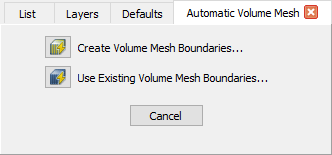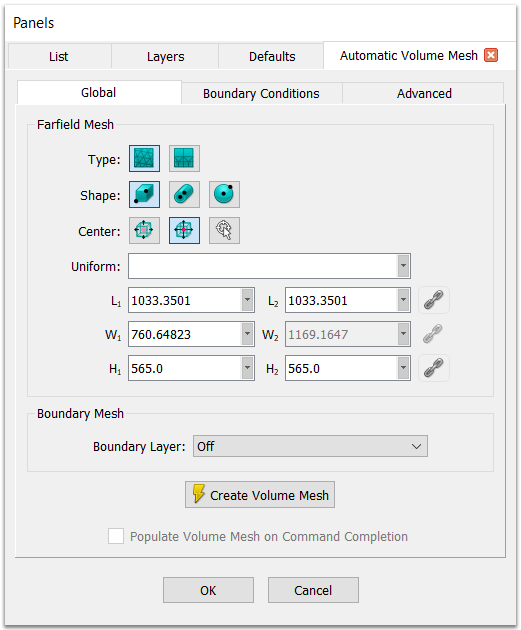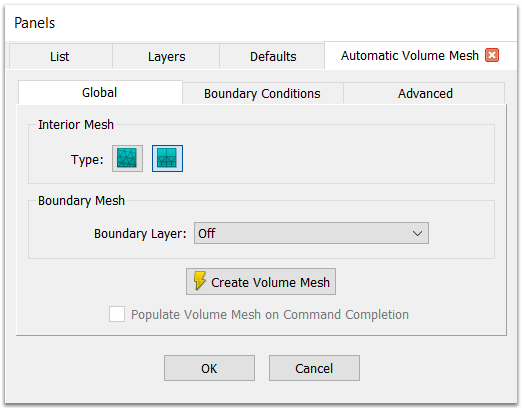
The initial panel for Automatic Volume Mesh lets you choose between modes to
create volume mesh boundaries or use existing boundaries.
The recommended starting point to use the Automatic Volume Mesh command is a surface
mesh (either created manually or by using the
Automatic Surface Mesh command).
Once these initial conditions are met, the command is designed to create an unstructured
block in an automated manner. The objective of this command is to create the desired volume grid
with minimum and intuitive input for defining the extents and the desired resolution of both the
boundary layer and isotropic regions of the mesh.
Upon invoking this command, you will be presented with a choice between two different modes
for Automatic Volume Mesh:
- Create Volume Mesh Boundaries
(
 ):
Automatically defines symmetry planes and farfield extents for external volume grids.
):
Automatically defines symmetry planes and farfield extents for external volume grids.
- Use Existing Volume Mesh Boundaries
(
 ):
Automatically defines volume mesh boundaries using the current domain selection. The
selection of domains must represent a closed watertight loop.
):
Automatically defines volume mesh boundaries using the current domain selection. The
selection of domains must represent a closed watertight loop.
Caution: To create volume meshes for internal flow cases
(i.e. the surface mesh defines the outer boundary of the volume), you need to create all
domains and necessary supporting geometry to create a completely closed
watertight volume and use the Use Existing Volume Mesh Boundaries mode. At this
time, the Create Volume Mesh Boundaries mode cannot create symmetry planes for
these types of blocks.
The options available within Automatic Volume Mesh change depending on which mode is selected.
The images show the Global tab for Create Boundaries mode (left) and Use Existing Boundaries
mode (right).
After making a selection on the initial panel, you will be presented with the Automatic
Volume Mesh panel shown above. The panel is split into three tabs: Global,
Boundary Conditions, and Advanced.
- Global: This panel presents tools for defining the farfield extents,
specifying the interior cell type, and prescribing resolution goals for the anisotropic
boundary layer.
- Boundary Conditions: This panel contains tools for assigning
boundary conditions which allow you to control how boundaries are used by T-Rex for creating
the boundary layer and whether or not they should be adapted by sources.
- Advanced: This panel contains more advanced tools for controlling the
characteristics of the resulting volume mesh including defining the
extents and controlling the interior isotropic resolution.
Note: All the settings in the Automatic Volume Mesh
functionality are stored in the Fidelity Pointwise project file as part of the Fidelity Pointwise environment.
Additionally, these settings can also be stored in a separate environment file using the Save Environment As command
available in the File menu. This capability enables you to reuse the same
Automatic Volume Mesh settings with different surface meshes without the need to
re-define them.
For more on Automatic Volume Mesh, choose a topic below:


